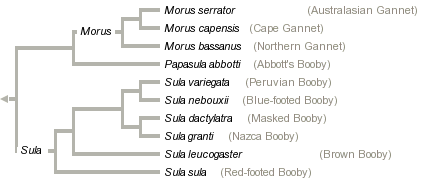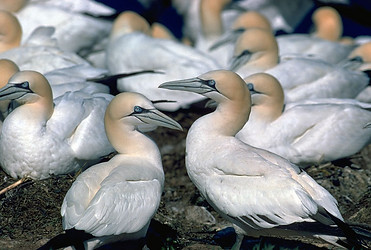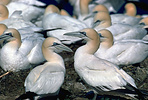Sulidae



This tree diagram shows the relationships between several groups of organisms.
The root of the current tree connects the organisms featured in this tree to their containing group and the rest of the Tree of Life. The basal branching point in the tree represents the ancestor of the other groups in the tree. This ancestor diversified over time into several descendent subgroups, which are represented as internal nodes and terminal taxa to the right.

You can click on the root to travel down the Tree of Life all the way to the root of all Life, and you can click on the names of descendent subgroups to travel up the Tree of Life all the way to individual species.
For more information on ToL tree formatting, please see Interpreting the Tree or Classification. To learn more about phylogenetic trees, please visit our Phylogenetic Biology pages.
close boxReferences
Friesen, V. L., and D. J. Anderson. 1997. Phylogeny and evolution of the Sulidae (Aves: Pelecaniformes): a test of alternative modes of speciation. Molecular Phylogentics and Evolution 7: 252-260.
Friesen, V. L., D. J. Anderson, T. E. Steeves, H. Jones, and E. A. Schreiber. 2002. Molecular support for the species status of the Nazca Booby (Sula granti). Auk 119: 820-826.
Nelson, J. B. 1978. The Sulidae: Gannets and Boobies. Oxford University Press, Oxford.
Pitman, R. L., and J. R. Jehl. 1998. Geographic variation and reassessment of species limits in the "Masked" Boobies of the eastern Pacific Ocean. Wilson Society Bulletin 110: 155-170.
Steeves, T. E., D. J. Anderson, and V. L. Friesen. 2005a. A role for nonphysical barriers to gene flow in the diversification of a highly vagile seabird, the masked booby (Sula dactylatra). Molecular Ecology 14: 3877-3887.
Steeves, T. E., D. J. Anderson, and V. L. Friesen. 2005b. The Isthmus of Panama: a major physical barrier to gene flow in a highly mobile pantropical seabird. Journal of Evolutionary Biology 18: 1000-1008.
Steeves, T. E., D. J. Anderson, H. McNally, M. H. Kim, and V. L. Friesen. 2003. Phylogeography of Sula: the role of physical barriers to gene flow in the diversification of tropical seabirds. Journal of Avian Biology 34: 217-223
Title Illustrations
| Scientific Name | Morus bassanus |
|---|---|
| Location | Bonaventure Island, Quebec, Canada |
| Comments | Northern Gannets interacting in large colony |
| Specimen Condition | Live Specimen |
| Copyright | © Greg and Marybeth Dimijian |







